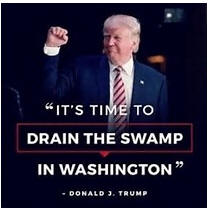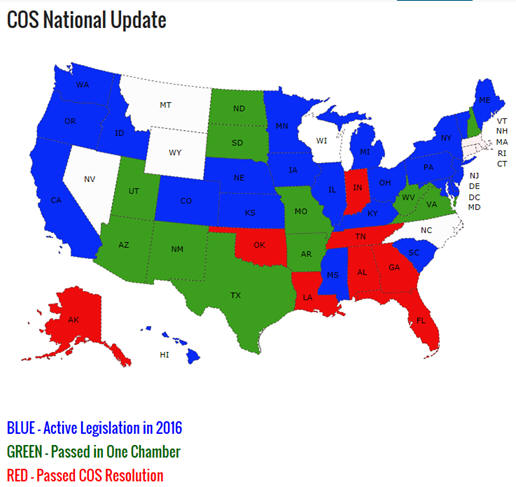'Tis Only My Opinion!™January 2017 - Volume 37, Number 1"Swamp Cleaning"How do you clean a swamp?First, you have to define what the swamp is?
Then, your have to decide how and where to start cleaning the swamp and the method to use. If the definition of a swamp is "the culture of our national government and its inability to live up to the founding documents", the task becomes gigantic and almost impossible to accomplish. The voters are responsible for cleaning the swamp!In the final analysis, it is the citizens of the representative democracy called the United States of America under its Constitution as amended that are those who must demand that the swamp be cleaned and elect members of Congress and the President to do the cleaning. In the 2016 election, only the office of the President could be seen as effecting change as most of the members of the House of Representatives and the Senate were re-elected. Since the Congress is responsible for all legislation and funding, it would appear that the money spigot will continue to run. For despite calls to set term-limits on our representatives, the outlook for the passage of such a bill would seem to be extremely unlikely. In the 2016 election to the House of Representatives, a total of 380 of the 393 House incumbents seeking re-election won, resulting in an incumbency rate of 96.7%. In the 2016 Senate election, 34 of the 100 seats were contested in regular elections. Only two incumbents lost their seats, Kelly Ayotte of New Hampshire and Mark Kirk of Illinois, both to Democrats Maggie Hassan and Tammy Duckworth, respectively. As these numbers suggest, the current political system makes it very difficult to effect change through the current voting system. Whether that is a function of the two-party system and party politics remains a question. Supposedly, the U.S. government is a government "of the people, by the people and for the people." The voters are shirking their responsibility ...Unfortunately, many of the people really don't care as the number of voters shows. In the recent election, considering a voting age population (VAP) of 251.1 million people and voting eligible population (VEP) of 231.6 million people, the turnout rate was only 55.3% of the VAP and 60.0% of the VEP. Voting turnout percentage was up compared to 2012 (54.9% VAP) but down compared to 2008 (58.2% VAP). In other words, 40% of the population could not be bothered to vote. Only the voters can clean the swamp!Of course, the most important and often-overlooked requirement is that the citizens that vote are legally-entitled to do so. In California, the state has issued to illegal aliens over 700.000 drivers licenses in just the last two years. In many states, all you need to have to vote is a utility bill with your name on it. Mail-in ballots are easily forged. Oregon has gone to all mail-in balloting. Other states, including: Colorado, Florida, Kansas, Minnesota, Missouri, Montana, Nevada, New Mexico, North Dakota, and Washington State, allow mail-in voting at one level or another, and may have restrictions on whether mail ballots may be used only for ballot questions, non-partisan races, etc. Political parties do not demand honest voting practices by people who are citizens of the U.S. as they perceive they might gain some advantage under the current system. Some of the methods that destroy the credibility of the voting booth are:
Requiring a government-issued ID also with the above would eliminate a significant portion of the fraud. In this age of computer databases, the ability to match names against various databases to highlight discrepancies is not a big deal. It just takes a decision that "only eligible voters will be allowed to vote" to set in motion the machinery to clean up the problem. Trump's SwampDuring the recent Presidential campaign, Donald Trump defined the swamp as being the Washington bureaucracy and proposed several measures that might help drain the swamp according to his definition. First, and most fundamentally, Trump wants to reduce the size of the federal government, and cut regulations and make them as simple as possible. Second, and more specifically, Trump wants to wrench the federal government from its cozy relationship with large, established businesses and institutions in areas ranging from health care to finance to education. Trump’s proposal would bar former White House officials and Congressional members from taking up positions as lobbyists for the first five years after they leave office, extending the one- to two-year ban created by the 2007 law. The boldest, part of Trump's plan is a Constitutional amendment imposing term limits on members of Congress. Other facets of his plan include barring the hiring of additional federal employees outside of military, public safety, and public health divisions, and placing a restriction on regulations, mandating that new federal regulations can only be put into place if two others are eliminated. Also, Trump would push for a complete ban on foreign lobbyists raising money for American elections. ConclusionAs we have shown, it is up to the voters to clean the swamp by demanding term limits and/or to limit their representatives to only a few terms. President-elect Trump can only begin the job using one of the three branches of government. The legislative branch must get aboard with Trump to truly effect change. For if they don't, they could face a major game-changer set forth in the U.S. Constitution in Article V. Article V of the Constitution itself lays out the rules for calling a "Convention of States"-- two-thirds of the states, or 34, have to petition Congress to call the meeting, according to Article V of the Constitution. The graphic below shows the current status of the movement.
If, during 2017, the Convention of States movement gains the required number of states, then everything is on the table and not just the Balanced Budget Amendment ... be careful of what you wish for! Swamp cleaning is needed ... let's hope that they don't throw out the whole enchilada! But then - 'Tis Only My Opinion!Fred Richards www.adrich.com Corruptisima republica plurimae leges. [The more corrupt a republic, the more laws.] -- Tacitus, Annals III 27 'Tis only My Opinion! Archive Menu, click here. This
issue of 'Tis Only My Opinion was copyrighted by Strategic Investing in 2017. |

